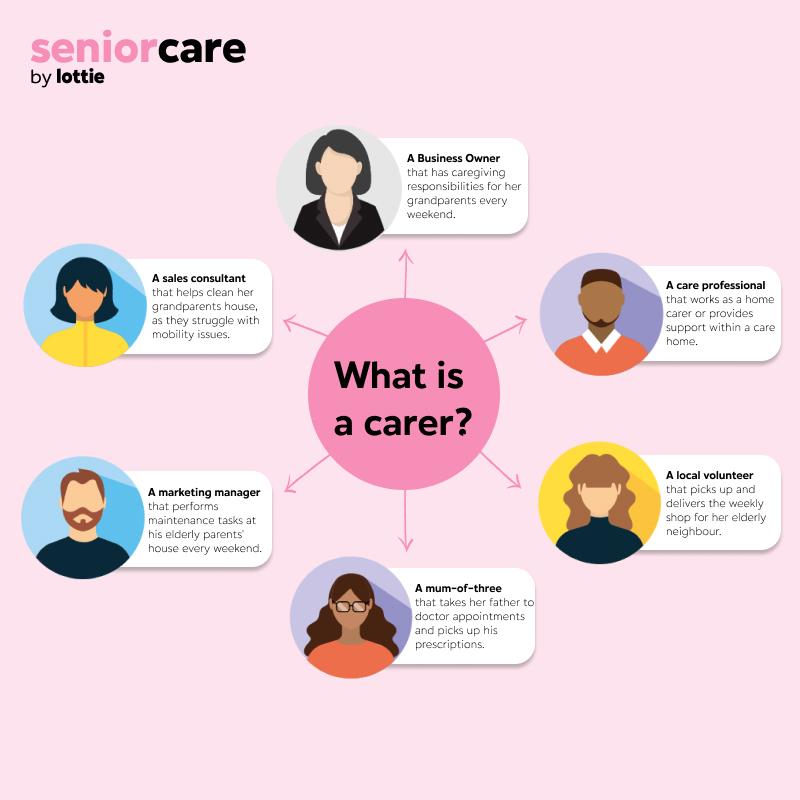What does a carer look like?
Forget what you think a carer looks like. It is estimated that unpaid carers provide £132 billion worth of care per year and they can be found everywhere.


Robin Hill
|
Copywriter
10 March 2023
When people think of carers they might think: uniform, care homes, institutions, professionals, occupation, dedication. There is a clear image of what we think a carer might look like, but in reality that image is totally different. The fact is, most people don’t recognise being a carer themselves. Perhaps it’s because they are not being paid to look after a loved one or they don’t spend their entire working week caring for an elderly relative, whatever the reason, many wouldn’t endow themselves with the title of ‘carer’.
The truth is; no matter how much time you put in and when you do it, it is still considered caring. You might be a small business owner, completely driven by keeping your company afloat and thriving, but every weekend you have to carry out caregiving responsibilities for your elderly grandparents. Whether it’s cleaning their house, picking up prescriptions or mowing the lawn, these caregiving responsibilities come in a variety of shapes and sizes. You might not even have a direct relation to the person you are caring for.
Since COVID-19, many communities have bound together to help out elderly people. Those shielding or more susceptible to the virus relied on friendly neighbours to pick up their weekly shop. This too is a form of caring that doesn’t come with a preset uniform or occupation. If the care adds up to 10 hours a week or just an hour after work every evening, you are a carer.

Unpaid care is at the heart of every organisation
This data, conducted by Harvard business school, clearly shows the lack of awareness and transparency when it comes to eldercare and work. From the employees’ perspective, they might not even realise how much their caregiving responsibilities affect their performance. From the perspective of the employer, they might not recognise just how much of an issue it really is for their workforce.
The first step for an organisation is understanding the problem and recognising that more and more employees will be affected by an ageing population. 1 in 7 employees care for an elderly acquaintance (c. 4.8 million people in the UK) which is set to increase to 1 in 6 by 2040. Increase and escalation aside, this is an endemic issue for organisations all over the UK. But fear not, below are four ways to begin identifying and addressing the costs of eldercare upon a workforce.
Reevaluate the costs of care on your organisation
The detrimental costs associated with care are widespread: absenteeism, presenteeism and staff turnover. All rack up such a substantial cost, that many businesses find it difficult to quantify or perhaps are just reluctant to quantify. Check out this handy tool to discover just how much eldercare might be costing your organisation.
Analyse how you currently support staff
You might provide a variety of schemes to support staff with eldercare concerns. However, there’s no point having 10 separate benefits when they are ineffective and underutilised. Talk to your employees, start a survey and discover how you can best support them. It could be more flexibility at work, salary sacrifice or a comprehensive benefit. Either way, ascertaining how best to support your staff and working out what works and what doesn’t is essential.
Communicate your policy on eldercare
If employees are finding it hard to discuss their eldercare experiences or even recognise that they might be a carer themselves, then it might be down to a lack of communication. Some employees may not even be aware of the kind of benefits you provide. Consistent communication on the subject will help create a care community and legitimise an individual’s care concerns. This communication will not only improve the support you provide, but also highlight your commitment to support caregivers in the workplace.
Develop a futureproof strategy for eldercare support
Once you have uncovered some of the data specific to your company and employees you can start creating a more comprehensive eldercare support solution. Speak to the friendly team at Seniorcare by Lottie, to create a service that is bespoke to your organisation. From an expert-led care concierge service to an exhaustive educational resource centre, Seniorcare by Lottie is able to give your employees holistic support on their eldercare enquiries. Understanding, finding and funding care for an elderly loved one has never been easier or more timely.
Other insights
A collection of engaging articles, guides and insights for leading Benefits Professionals



